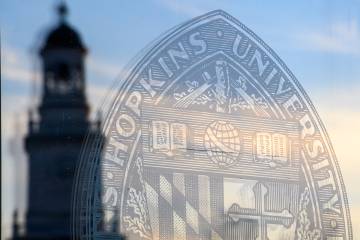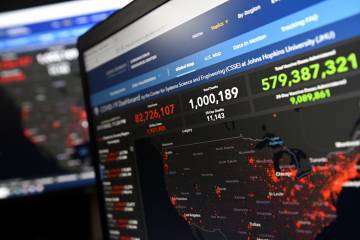- Name
- Johns Hopkins Media Relations
- jhunews@jhu.edu
- Office phone
- 443-997-9009
This week, the federal government is set to roll back its COVID-19 public health emergency declaration, a month after President Biden signed a bipartisan congressional resolution to end the national emergency declaration. At the same time, the White House is loosening federal guidelines on COVID vaccines—another signal from officials that the worst of the pandemic is behind us.
"It is important to reflect on the remarkable progress that has been made in developing COVID-19 vaccines and in conducting the largest global mass vaccination campaign ever," says William Moss, professor in the Departments of Epidemiology, International Health and Molecular Microbiology and Immunology at the Johns Hopkins Bloomberg School of Public Health and Executive Director of the International Vaccine Access. Still, Moss cautions that vaccine-related difficulties remain a concern.
"It has become more complex and messier to evaluate vaccine effectiveness because of the changing variants and hybrid immunity in the population—people have different histories of vaccination and infection," he says. "That said, the bivalent booster vaccines continue to provide protection against severe disease, although the level of protection wanes."
Given these kind of improvements with an asterisk, is this the right time to end these pandemic provisions, which included not just free vaccines, but easier access to Medicaid enrollment, support for small businesses, and personal protective equipment in schools, along with many other life-saving supports? Will the changes wreak havoc on the lives of citizens who are immunocompromised or still experiencing pandemic aftershocks? Moss will join a panel of Johns Hopkins experts to address those questions and more in a live, virtual briefing at 10:30 a.m. EDT on Wednesday, May 10; registration is required.
Ahead of the briefing, the Hub reached out to several other researchers across the university for their insights on the potential effects of the end of the emergency declarations.
Emergencies shouldn't last forever
David Dowdy, professor in the Department of Epidemiology at the Johns Hopkins Bloomberg School of Public Health
The end of the public health emergency declaration will undoubtedly cause some funding streams to end, but it's also important to recognize that emergencies can't—and don't—last forever. My hope is that we can use this pivot as an opportunity to shift some of the funding that has been used for the COVID-19 response to our nation's other pressing public health issues, from the opioid epidemic to the mental health crisis to longstanding challenges like health disparities and cancer—issues that have been made worse by COVID-19 and that we will be dealing with for decades to come. I hope we can see the COVID-19 pandemic as a wake-up call to strengthen our country's public health infrastructure so that we can be better prepared for the next emergency while also dealing with the problems that hurt our nation's health, day after day after day.
Continuing to say 'yes, we can' to innovative programs and care
Keri Althoff, associate professor in the Department of Epidemiology at the Johns Hopkins Bloomberg School of Public Health
There were so many things that happened during the COVID-19 public health emergency that allowed us to say, "Turns out, we can do that" to programs that were not believed to be feasible. For example, the federal government ensured free school lunch to more than 50 million public school children to protect them from hunger during the pandemic. The federal program ended in September 2022, but many states passed, or are considering passing, bills to ensure free public school lunches continue. In a recent study by Johns Hopkins Bloomberg School of Public Health investigators, the impact of 2016 standards for more nutritional public school lunches decreased body mass index among U.S. children; the study used data from pre-pandemic years. Moving forward, we should study the impact of public school lunches on the health of children in states with (compared to without) free school lunch.
The expansion of telehealth was a tremendous success that was driven by the necessity to deliver and receive care and in the safest environment possible, when hospitals and outpatient clinics were full of people ill with COVID. Before COVID, the promise of telehealth was thought to be rooted in reaching those with large barriers to accessing healthcare, like rural populations accessing sub-specialty care or among those who experience stigma, unstable transportation, or non-routine work hours. Telehealth removed important barriers to accessing care for so many people. Although the pandemic-related suspension of telemedicine regulations has expired, I suspect the field of telehealth will continue to move forward, propelled by a much larger demand than what existed prior to the pandemic. Telehealth-based mental health care is currently a prominent example.
The clock is ticking on Medicaid's emergency expansion
Joshua M. Sharfstein, Vice Dean for Public Health Practice and Community Engagement, Director of the Bloomberg American Health Initiative, and Professor of the Practice in Health Policy and Management at the Johns Hopkins Bloomberg School of Public Health
One of the major issues is Medicaid redetermination. During the pandemic, everyone on Medicaid was permitted to stay on Medicaid. Now they have to prove they are eligible. In Maryland, this is well more than 1 million people. If people inappropriately get dropped, they'll lose coverage. An unnecessary decline in coverage could also adversely affect health care providers, including Johns Hopkins. Fortunately, the state is launching a major campaign to keep people who remain eligible enrolled. The success of this campaign will be important for health in the state.
Medicaid eligibility checks will be costly for poor families
Robert Moffitt, Krieger-Eisenhower Professor of Economics, Krieger School of Arts and Sciences
During the pandemic, most eligibility tests for Medicaid were suspended. As a consequence, many families who became ineligible because of an increase in income or other circumstance were allowed to keep their benefits. It is only proper that, with the end of the pandemic, eligibility tests start to being applied again. There are two issues, however. One is that checking eligibility is a complex and onerous task and there is a risk that some families may fall through the cracks and will be terminated from the program even though they are eligible because they are not able to reestablish eligibility quickly enough. Families need assistance from Medicaid personnel and need the time to reestablish eligibility. The other problem is that some states still do not cover certain Medicaid groups who deserve coverage, despite encouragement from the Affordable Care Act, and some families will lose assistance because of this continued problem with eligibility rules in those states.
It's now up to us to embrace effective public health tools
Jonathan Links, Professor, Vice Provost, and Chief Risk Officer, Johns Hopkins University
One of the many important lessons the pandemic has tried to teach us is that we actually have the power, individually, to significantly reduce our risk of acquiring any respiratory illness. A powerful public health model of behavior change—the Extended Parallel Process Model—illustrates that people change their behavior toward reducing risk when they perceive a threat and believe there is an efficacious harm reduction behavior that they themselves can implement. With the pandemic, we gained at least two: masks and vaccines. While both came with controversy of one sort or another, they represent powerful self-efficacious tools that we can embrace beyond COVID.
Posted in Health, Voices+Opinion
Tagged public health, coronavirus, covid-19










